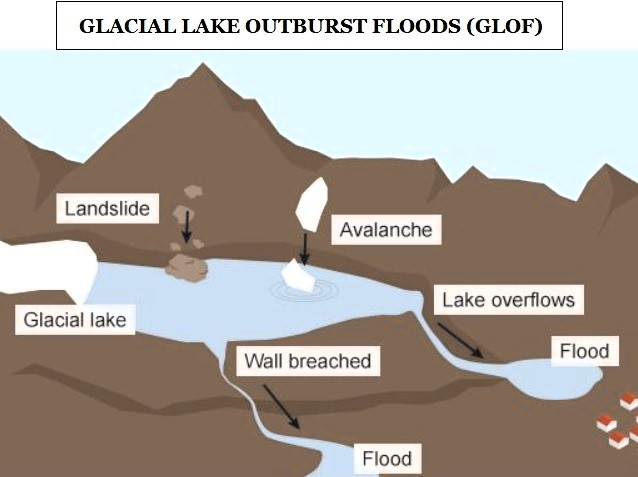Glacial Lake Outburst Flood
What is GLOF?
- Glacial lakes are large bodies of water that sit in front of, on top of, or beneath a melting glacier.
- A Glacial Lake Outburst Flood, or GLOF, is a sudden release of water from a lake fed by glacier melt that has formed at the side, in front, within, beneath, or on the surface of a glacier.
- As the Glacial lakes grow larger, they become more dangerous because glacial lakes are mostly dammed by unstable ice or sediment composed of loose rock and debris.
- In case the boundary around them breaks, huge amounts of water rush down the side of the mountains, which could cause flooding in the downstream areas.
Causes of GLOF
- The primary trigger for a GLOF is the collapse or breach of a moraine dam or ice dam holding back water in a glacial lake.
- This can be caused by factors such as glacial melt water, avalanches, earthquakes or volcanic activity.

- Landslides can trigger GLOFs by displacing water or blocking waterways, creating sudden surges of water.
- Heavy rainfall, or intense melting due to heatwaves can destabilize ice dams or increase water pressure in proglacial lakes, triggering GLOFs.
Potential Impacts
- The sudden release of water by GLOFs can cause widespread flooding, inundating homes, farms, infrastructure, and transportation networks.
- In some cases, GLOFs can trigger landslides and mudflows, further endangering lives and property.
- The sudden release of water and debris can destroy habitats, disrupt food chains, and contaminate water sources.
- GLOFs can erode fertile topsoil and degrade land, reducing agricultural productivity.
- GLOFs can lead to long-lasting social and economic consequences, including the displacement of communities, loss of assets, and increased vulnerability to future hazards.
Subscribe
Login
0 Comments
